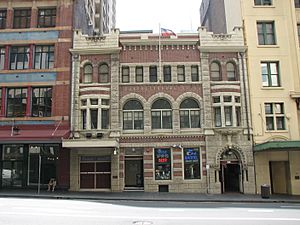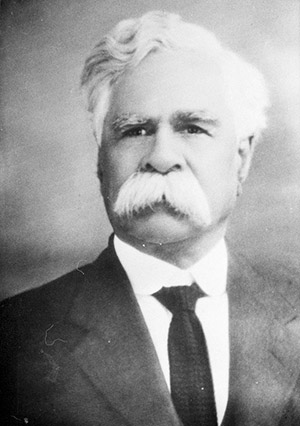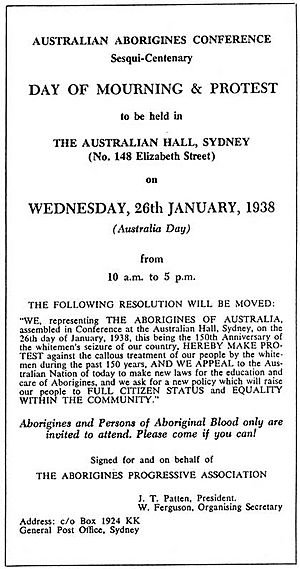Australian Hall facts for kids
Quick facts for kids Australian Hall (Cyprus–Hellene Club) |
|
|---|---|

Australian Hall
|
|
| Location | 150–152 Elizabeth Street, Sydney CBD, City of Sydney, New South Wales, Australia |
| Built | 1910–1913 |
| Built for | Concordia German Club |
| Architectural style(s) |
|
| Owner | Indigenous Land Corporation |
| Official name: Cyprus Hellene Club - Australian Hall | |
| Type | Listed place (Indigenous) |
| Designated | 20 May 2008 |
| Reference no. | 105937 |
| Official name: Cyprus-Hellene Club; Australian Hall; Aboriginal Day of Mourning Site; Concord Club; | |
| Type | State heritage (built) |
| Criteria | a., b., d., f. |
| Designated | 2 April 1999 |
| Reference no. | 773 |
| Type | Hall Public |
| Category | Aboriginal |
| Builders | J. Ptolemy |
| Lua error in Module:Location_map at line 420: attempt to index field 'wikibase' (a nil value). | |
The Australian Hall is a special building in Sydney, Australia. It is located on Elizabeth Street in the city center. This building is important because it was the site of a very significant protest. On 26 January 1938, Aboriginal Australians held a protest there called the Day of Mourning. This event highlighted how Aboriginal people were treated unfairly.
For some time, the building was also known as the Cyprus–Hellene Club. Today, the Indigenous Land Corporation owns it. This is an Australian Government group. The Australian Hall is recognized as a heritage site. It was added to the Australian National Heritage List in 2008. It was also added to the New South Wales State Heritage Register in 1999.
Australian Hall: A Special Place
What is the Australian Hall?
The Australian Hall is a historic community building. It is in the heart of Sydney. It looks like a strong, old building. It has three floors and a basement. The building was made with brick and stone. It shows a style called Federation Romanesque. This style uses rounded arches and rough-looking stone.
A Building with Many Lives
The Australian Hall has been used for many different things. It has changed owners and purposes several times. Each change added to its unique story.
From German Club to Theatre
The building was first built between 1910 and 1913. It was for a group called the Concordia German Club. In 1920, a Catholic group bought it. They were called the Knights of the Southern Cross. In 1922, the hall inside was named the Australian Hall.
Later, in 1961, the building changed again. It became the Phillip Theatre. The inside was changed to fit 453 people. This theatre was important for new Australian plays.
Movies and Cultural Gatherings
By the 1970s, it became hard to find shows for the theatre. So, in 1974, it turned into a cinema. It was first called the Rivoli Cinema. Then, it became the Mandarin Cinema. It showed Chinese language films.
In 1979, the Knights of the Southern Cross sold the building. A group called the Hellenic Club bought it. They used it as the Cyprus Hellene Club. This club helped Greek Cypriots in Australia. It kept their culture alive. The club also rented out the old hall. It continued to be a cinema until 1988. The building also had a restaurant and other community spaces.
The building was also important for Australian politics. In 1900, the first national meeting of the Australian Labor Party happened here. They created a national political plan. Later, in 1965, the party met here again. They decided to remove the "White Australia policy" from their rules. This policy had limited who could come to Australia.
In the 1990s, the club wanted to knock down most of the building. They planned to build a tall apartment building. But Indigenous people and heritage groups fought to save it. They wanted to protect it because of its link to the Day of Mourning.
The Day of Mourning: A Key Moment
The Australian Hall became very important to Indigenous people. This was because of the Day of Mourning protest.
Why the Day of Mourning Happened
Since Europeans arrived in Australia, Indigenous Australians were treated differently. They did not have the same rights as white people. They often faced unfair laws. Indigenous people have always protested against this. Early protests were usually about local problems. They sent letters and petitions.
For example, in the 1840s, people at Wybalenna on Flinders Island protested. They sent letters to Queen Victoria. They complained about their living conditions. In the 1870s, people at Coranderrk in Victoria also protested. They used newspapers and asked for help from other groups.
This kind of protest continued. In the 1880s and 1890s, people at Cummeragunja and Poonindie also wrote letters. They asked for land to farm for their families.
In the late 1920s, new groups started. These were Aboriginal-led organizations. One of the first was the Australian Aboriginal Progressive Association (AAPA). It was started by Fred Maynard. Other groups formed in New South Wales and Victoria. Key leaders included William Cooper, Doug Nicholls, Margaret Tucker, William Ferguson, Jack Patten and Pearl Gibbs.
Many of these leaders grew up on missions or reserves. These places were controlled by special boards. They saw how unfair the laws were. They also experienced problems finding jobs or owning property. These shared experiences brought them together. They wanted civil rights for Aboriginal people. They also wanted to change the harsh rules of the Aborigines Protection Board.
The Big Protest in 1938
In November 1937, William Cooper called a meeting. He met with William Ferguson in Melbourne. They decided to hold a big protest in Sydney. It would happen on 26 January 1938. This date was Australia Day. It was also 150 years since the First Fleet arrived. They called this protest the Day of Mourning.
The groups told everyone about the protest. They used radio and other media. Jack Patten and William Ferguson visited reserves. They encouraged Aboriginal people to come. They also wrote a pamphlet. It was called "Aborigines Claim Citizen Rights." This pamphlet explained why the protest was happening. It said that 26 January was not a day of joy for Aboriginal people. It was a day of sadness. It marked 150 years of hardship for them.
The pamphlet asked white Australians for fairness. It asked them to include Aboriginal people fully in the nation. The organizers wanted to hold the protest at Sydney Town Hall. But they were not allowed. So, they rented the Australian Hall. They had to agree to watch the Australia Day parade first. Then they would march to the hall.
The official Australia Day celebrations included a re-enactment. It showed Governor Phillip arriving at Port Jackson. Aboriginal people from a reserve were brought in for this. They were kept separate from others. This was to stop any problems.
The protest delegates did not watch the re-enactment. They watched a pageant at Sydney Town Hall. Then they walked to the Australian Hall. Police officers guarded the door. Attending the protest was risky for Aboriginal people. They could be jailed or lose their homes. So, some entered through the back door. This helped them avoid being identified.
More than 100 Aboriginal people attended. They came from different parts of Australia. They sent messages of support from other states. This made it a national protest.
What the Protest Achieved
After many speeches, they agreed on a statement. They demanded full citizen rights. They protested the unfair treatment of their people. They asked for new laws for education and care. They wanted Aboriginal people to have full citizen status. This meant equal rights with white Australians. They wanted the same education, wages, and pensions. They also wanted to own land and save money.
On 31 January 1938, a group presented this statement. They also gave a ten-point plan to the Prime Minister. This plan was what Aboriginal people wanted. It asked for the Australian Government to control all Aboriginal affairs. It wanted a national policy for Aboriginal people. It also wanted a Minister for Aboriginal Affairs. This minister would work to give Aboriginal people full citizen rights.
The plan also suggested land settlements. It wanted to help Aboriginal people become self-supporting farmers. It also said that Aboriginal Reserves should be kept. These would be safe places for some Aboriginal people.
A newspaper called Abo Call reported on the Day of Mourning. It was the first newspaper published by Aboriginal people. It said the protest was the first time Aboriginal people from different states joined together. They campaigned for equality and full citizenship.
The Day of Mourning did not bring big changes right away. But it created important ideas. These ideas are still important today. For example, the idea of the Australian Government controlling Aboriginal affairs led to a big change. This was the 1967 Referendum. In this vote, Australians agreed to change the constitution.
Many Indigenous leaders today still see the Day of Mourning as important. Noel Pearson said that the ideas from 1938 are still relevant. Gatjil Djerrkura also noted that many issues from that time still exist. These include health and economic opportunities.
The call for "full citizen status" and "equality" from the Day of Mourning is still heard today. It is in many government reports. It is also in Indigenous statements. These include the Yirrkala Bark Petition and the Barunga Statement.
The Day of Mourning showed that Indigenous people were left out of the Australian nation. This is still an issue. So, Indigenous people continue to use Australia Day for protests. In 1970, another Day of Mourning was held. In 1972, the Aboriginal Tent Embassy was set up in Canberra. This was to ask for land rights and self-determination. In 1988, there was a huge protest on Australia Day.
In the 1930s, asking for equal rights was a very bold step. It challenged the way things were. Because of this, the Day of Mourning is seen as one of the most important moments for Indigenous resistance in the early 20th century.
The Building Today
The Cyprus Hellene Club - Australian Hall is still at 150-152 Elizabeth Street, Sydney.
Inside and Out
The building is made of stone and brick. It has a classic look with arches. The front of the building on Elizabeth Street has a fabric awning. The building has three entrances. The main cinema entrance has marble steps. The club entrance has special stone steps.
Inside, the building has changed over time. But some original parts remain. The former Australian Hall is on the first floor. Its entrance lobby still has old decorations. The front and back doors are still the same.
The basement has storage rooms and toilets. The ground floor has a large bar and restaurant. It also has a kitchen and toilets. The first floor has a board room and snooker room. The Mandolin Cinema is also on this floor. This used to be the Australian Hall. It still has many original features. These include the ceiling and wall decorations. The second floor has a large function room.
Why This Building is Important
The Australian Hall is in good condition. Changes inside have not taken away its importance. Especially its link to the Day of Mourning.
It is important because it shows the history of New South Wales. It was the site of the first organized Aboriginal Civil Rights protest. This event started the modern Aboriginal political movement. It led to a list of demands for change. This list was given to the Prime Minister. The building is important for Aboriginal and Australian political history. It marks the start of the ongoing fight for Aboriginal rights.
The Cyprus-Hellene Club is also important for its connections to different groups. It was a place for the German Concordia Club. It was also a place for the Greek-Cypriot community. It helped them keep their culture alive. It also has a link to the Knights of the Southern Cross. And to the Asian community in Sydney, through the cinema.
The building is a rare example of a place that has been used continuously for social and cultural events. It is also rare because it is important to both Aboriginal and European communities. It is especially significant for Aboriginal people.
See Also
- Day of Mourning (Australia)
- Indigenous Land Corporation
- Australian National Heritage List
- New South Wales State Heritage Register
Images for kids










